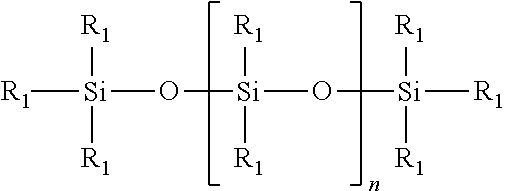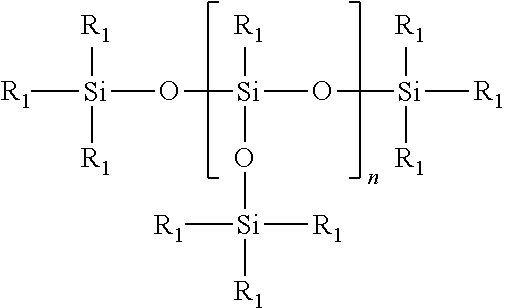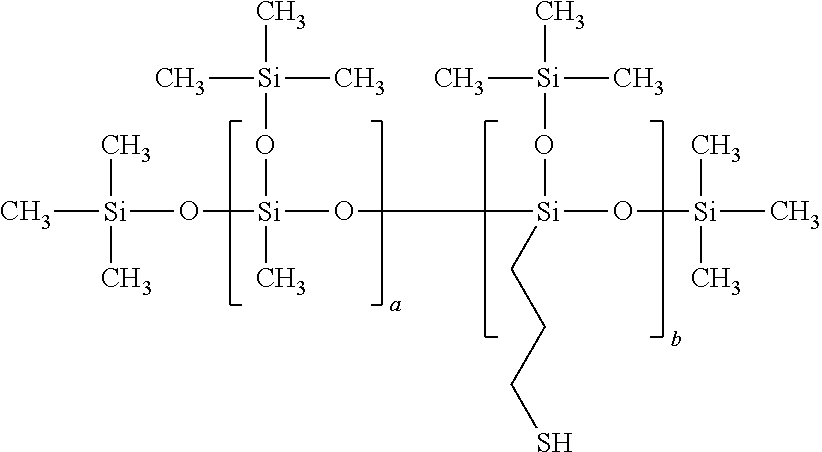Composition and method for thermally activated hair treatment
a technology of thermal hair treatment and formulation, which is applied in the direction of hair cosmetics, toilet preparations, curling devices, etc., can solve the problems of alone not providing the properties of lasting sets, and not providing satisfactory lasting sets after treatment, etc., to achieve excellent permanent or semi-permanent straightening results
- Summary
- Abstract
- Description
- Claims
- Application Information
AI Technical Summary
Benefits of technology
Problems solved by technology
Method used
Image
Examples
example 1
Uncapped Gamma-Mercaptopropyl, Methylpolysiloxane Homopolymer:
[0048]To a five neck 500 ml reactor equipped with nitrogen inlet, condenser, stirrer and temperature probe and addition funnel, was added 50 ml H2O containing 0.070 g concentrated HCl. 180 g mercaptopropyl, methyldimethoxysilane was added dropwise over 30 minutes to the reactor and allowed mix for 5 hours. The reaction exothermed slightly during the silane addition.
[0049]The reaction product was transferred to a separation funnel and the aqueous phase removed. The silicone phase was washed and separated with 50 ml water and 200 ml toluene. Some NaCl was added to form a clear separation layer. The toluene layer was washed 2× more time in the same manner with added water before being dried over excess anhydrous magnesium sulfate and filtered. The toluene was distilled off between 70° C.-150° C. A vacuum distillation at 150° C. removed any light ends to yield 125.5 g of an oily product with a density of 1.10 g / ml. This polym...
example 2
[0050]0.1 g of the product of example 1 was dissolved in 1 g. isopropyl alcohol and applied to a dry 2.5 g. frizzy / curly hair tress, massaged in and combed with a fine toothed comb. The tress was then flat ironed 10 times with a Babylys styling iron set at 400° F. The tress was thin and straight and conditioned. The smoke generated during hot combing was medium high and required proper ventilation. It was allowed to cool and then immediately washed for eight cycles using Suave daily clarifying shampoo containing sulfate-type surfactants. It was completely dried using a blow dryer after the 1st, 4th and 8th cycle. The tress was completely thin and straight after all 8 wash dry cycles. A second tress was similarly processed, but at only 325° F. It failed after the first wash cycle, thus showing temperature dependence.
example 3
[0051]In a manner similar to that of example 1, a dimethyl, mercaptopropylsiloxane copolymer containing about a 1:1 mole ratio of mercapto-functional silicone to methyl functional silicone was prepared by condensing and equilibrating mercaptopropylmethyldimethoxysilane, hexamethyldisiloxane and dimethyldimethoxy silane. The product was slightly turbid oil that is characterized as 50 mole % mercaptofunctional, calculated to be between about 12-13% SH group.
PUM
| Property | Measurement | Unit |
|---|---|---|
| kinematic viscosity | aaaaa | aaaaa |
| temperature | aaaaa | aaaaa |
| mole ratio | aaaaa | aaaaa |
Abstract
Description
Claims
Application Information
 Login to View More
Login to View More - R&D
- Intellectual Property
- Life Sciences
- Materials
- Tech Scout
- Unparalleled Data Quality
- Higher Quality Content
- 60% Fewer Hallucinations
Browse by: Latest US Patents, China's latest patents, Technical Efficacy Thesaurus, Application Domain, Technology Topic, Popular Technical Reports.
© 2025 PatSnap. All rights reserved.Legal|Privacy policy|Modern Slavery Act Transparency Statement|Sitemap|About US| Contact US: help@patsnap.com



